Evolution of Virtual Water Transfers in China’s Provincial Grids and Its Driving Analysis
Abstract
1. Introduction
2. Materials and Methods
2.1. Modeling Virtual Water Network Embodied in Electricity Trade
2.2. Virtual Water Transmission and Decomposition Analysis Model
2.3. Study Area
2.4. Data Sources
3. Results
3.1. Virtual Water Transfers Embodied in Electricity Transmission
3.2. Driving Forces of Overall Virtual Water Transfers
3.3. Driving Forces Analysis at the Provincial Level
4. Discussion
4.1. Impacts of Policies to the Virtual Water Transmission
4.2. Advice for the Development of China’s Power System
4.3. Advantages and Limitations
5. Conclusions
Supplementary Materials
Author Contributions
Funding
Conflicts of Interest
References
- Fang, D.; Chen, B. Linkage analysis for water-carbon nexus in China. Appl. Energy 2018, 225, 682–695. [Google Scholar] [CrossRef]
- Larsen, M.A.D.; Drews, M. Water use in electricity generation for water-energy nexus analyses: The European case. Sci. Total Environ. 2019, 651, 2044–2058. [Google Scholar] [CrossRef] [PubMed]
- Li, J.S.; Chen, G.Q. Water footprint assessment for service sector: A case study of gaming industry in water scarce Macao. Ecol. Indic. 2014, 47, 164–170. [Google Scholar] [CrossRef]
- China State Council (CSC). Opinions of the State Council on the Implementation of the Strictest Water Resources Management System. 2012. Available online: http://www.gov.cn/zwgk/2012-02/16/content_2067664.htm (accessed on 18 December 2019).
- Ministry of Water Resources of China. China Water Resources Bulletin in 2018. Available online: http://www.gov.cn/xinwen/2019-07/13/content_5408959.htm (accessed on 18 December 2019).
- Cai, B.; Zhang, B.; Bi, J.; Zhang, W. Energy’s Thirst for Water in China. Environ. Sci. Technol. 2014, 48, 11760–11768. [Google Scholar] [CrossRef] [PubMed]
- Nogueira Vilanova, M.R.; Perrella Balestieri, J.A. Exploring the water-energy nexus in Brazil: The electricity use for water supply. Energy 2015, 85, 415–432. [Google Scholar] [CrossRef]
- Farfan, J.; Breyer, C. Combining Floating Solar Photovoltaic Power Plants and Hydropower Reservoirs: A Virtual Battery of Great Global Potential. Energy Procedia 2018, 155, 403–411. [Google Scholar] [CrossRef]
- Zhang, J.; Lei, X.; Chen, B.; Song, Y. Analysis of blue water footprint of hydropower considering allocation coefficients for multi-purpose reservoirs. Energy 2019, 188, 116086. [Google Scholar] [CrossRef]
- Zaunbrecher, B.S.; Daniels, B.; Roß-Nickoll, M.; Ziefle, M. The social and ecological footprint of renewable power generation plants. Balancing social requirements and ecological impacts in an integrated approach. Energy Res. Soc. Sci. 2018, 45, 91–106. [Google Scholar] [CrossRef]
- Sharifzadeh, M.; Hien, R.K.T.; Shah, N. China’s roadmap to low-carbon electricity and water: Disentangling greenhouse gas (GHG) emissions from electricity-water nexus via renewable wind and solar power generation, and carbon capture and storage. Appl. Energy 2019, 235, 31–42. [Google Scholar] [CrossRef]
- He, G.; Zhao, Y.; Jiang, S.; Zhu, Y.; Li, H.; Wang, L. Impact of virtual water transfer among electric sub-grids on China’s water sustainable developments in 2016, 2030, and 2050. J. Clean. Prod. 2019, 239, 118056. [Google Scholar] [CrossRef]
- Murrant, D.; Quinn, A.; Chapman, L.; Heaton, C. Water use of the UK thermal electricity generation fleet by 2050: Part 1 identifying the problem. Energy Policy 2017, 108, 844–858. [Google Scholar] [CrossRef]
- Murrant, D.; Quinn, A.; Chapman, L.; Heaton, C. Water use of the UK thermal electricity generation fleet by 2050: Part 2 quantifying the problem. Energy Policy 2017, 108, 859–874. [Google Scholar] [CrossRef]
- Allan, J.A. Virtual Water: A Strategic Resource Global Solutions to Regional Deficits. Groundwater 1998, 36, 545–546. [Google Scholar] [CrossRef]
- Allan, T. (School of O and AS.) Fortunately there are substitutes for water: Otherwise our hydropolitical futures would be impossible. In Bibliographic Information; Overseas Development Administration: London, UK, 1993. [Google Scholar]
- Feng, K.; Hubacek, K.; Siu, Y.L.; Li, X. The energy and water nexus in Chinese electricity production: A hybrid life cycle analysis. Renew. Sustain. Energy Rev. 2014, 39, 342–355. [Google Scholar] [CrossRef]
- Pfister, S.; Saner, D.; Koehler, A. The environmental relevance of freshwater consumption in global power production. Int. J. Life Cycle Assess. 2011, 16, 580–591. [Google Scholar] [CrossRef]
- Zhang, C.; Anadon, L.D. Life Cycle Water Use of Energy Production and Its Environmental Impacts in China. Environ. Sci. Technol. 2013, 47, 14459–14467. [Google Scholar] [CrossRef]
- Zhu, X.; Guo, R.; Chen, B.; Zhang, J.; Hayat, T.; Alsaedi, A. Embodiment of virtual water of power generation in the electric power system in China. Appl. Energy 2015, 151, 345–354. [Google Scholar] [CrossRef]
- Guo, R.; Zhu, X.; Chen, B.; Yue, Y. Ecological network analysis of the virtual water network within China’s electric power system during 2007–2012. Appl. Energy 2016, 168, 110–121. [Google Scholar] [CrossRef]
- Zhang, C.; Zhong, L.; Liang, S.; Sanders, K.T.; Wang, J.; Xu, M. Virtual scarce water embodied in inter-provincial electricity transmission in China. Appl. Energy 2017, 187, 438–448. [Google Scholar] [CrossRef]
- Chini, C.M.; Djehdian, L.A.; Lubega, W.N.; Stillwell, A.S. Virtual water transfers of the US electric grid. Nat. Energy 2018, 3, 1115–1123. [Google Scholar] [CrossRef]
- Zhang, Y.Y.; Fang, J.K.; Wang, S.G.; Yao, H. Energy-water nexus in electricity trade network: A case study of interprovincial electricity trade in China. Appl. Energy 2020, 257, 113685. [Google Scholar] [CrossRef]
- NDRC (National Development and Reform Commission); NEA (National Energy Administration). Energy Production and Consumption Revolution Strategy; NDRC and NEA: Beijing, China, 2016. Available online: http://www.ndrc.gov.cn/gzdt/201704/t20170425_845304.html (accessed on 18 December 2019).
- Yan, D.; Lei, Y.; Li, L. Driving Factor Analysis of Carbon Emissions in China’s Power Sector for Low-Carbon Economy. Math. Probl. Eng. 2017, 2017, 4954217. [Google Scholar] [CrossRef]
- Hoekstra, R.; van den Bergh, J.C.J.M. Comparing structural decomposition analysis and index. Energy Econ. 2003, 25, 39–64. [Google Scholar] [CrossRef]
- Goh, T.; Ang, B.W.; Su, B.; Wang, H. Drivers of stagnating global carbon intensity of electricity and the way forward. Energy Policy 2018, 113, 149–156. [Google Scholar] [CrossRef]
- Liao, X.; Hall, J.W. Drivers of water use in China’s electric power sector from 2000 to 2015. Environ. Res. Lett. 2018, 13, 094010. [Google Scholar] [CrossRef]
- Zhang, Y.; Chen, Q.; Chen, B.; Liu, J.; Zheng, H.; Yao, H.; Zhang, C. Identifying hotspots of sectors and supply chain paths for electricity conservation in China. J. Clean. Prod. 2020, 251, 119653. [Google Scholar] [CrossRef]
- Cai, B.; Zhang, W.; Hubacek, K.; Feng, K.; Li, Z.; Liu, Y.W.; Liu, Y. Drivers of virtual water flows on regional water scarcity in China. J. Clean. Prod. 2019, 207, 1112–1122. [Google Scholar] [CrossRef]
- Wang, S.; Zhu, X.; Song, D.; Wen, Z.; Chen, B.; Feng, K. Drivers of CO2 emissions from power generation in China based on modified structural decomposition analysis. J. Clean. Prod. 2019, 220, 1143–1155. [Google Scholar] [CrossRef]
- Zhang, C.; He, G.; Zhang, Q.; Liang, S.; Zipper, S.C.; Guo, R.; Zhao, X.; Zhong, L.; Wang, J. The evolution of virtual water flows in China’s electricity transmission network and its driving forces. J. Clean. Prod. 2020, 242, 118336. [Google Scholar] [CrossRef]
- Dietzenbacher, E.; Los, B. Structural Decomposition Techniques: Sense and Sensitivity. Econ. Syst. Res. 1998, 10, 307–324. [Google Scholar] [CrossRef]
- NDRC (National Development and Reform Commission). The 13th Five-Year (2016–2020) Development Plan for Electric Power Industry; NDRC: Beijing, China, 2017. Available online: https://en.ndrc.gov.cn/ (accessed on 18 December 2019).
- Liu, M.; Huang, Y.; Ma, Z.; Jin, Z.; Liu, X.; Wang, H.; Liu, Y.; Wang, J.; Jantunen, M.; Bi, J.; et al. Spatial and temporal trends in the mortality burden of air pollution in China: 2004–2012. Environ. Int. 2017, 98, 75–81. [Google Scholar] [CrossRef] [PubMed]
- Zhang, C.; Zhong, L.; Wang, J. Decoupling between water use and thermoelectric power generation growth in China. Nat. Energy 2018, 3, 792–799. [Google Scholar] [CrossRef]
- CEC (China Electricity Council). Annual Compilation of Statistics of Power Industry; China Electricity Council: Beijing, China, 2005–2014. (In Chinese) [Google Scholar]
- Li, X.; Feng, K.; Siu, Y.L.; Hubacek, K. Energy-water nexus of wind power in China: The balancing act between CO2 emissions and water consumption. Energy Policy 2012, 45, 440–448. [Google Scholar] [CrossRef]
- Pfister, S.; Koehler, A.; Hellweg, S. Assessing the Environmental Impacts of Freshwater Consumption in LCA. Environ. Sci. Technol. 2009, 43, 4098–4104. [Google Scholar] [CrossRef] [PubMed]
- Krzywinski, M.; Schein, J.; Birol, İ.; Connors, J.; Gascoyne, R.; Horsman, D.; Jones, S.J.; Marra, M.A. Circos: An information aesthetic for comparative genomics. Genome Res. 2009, 19, 1639–1645. [Google Scholar] [CrossRef]
- Wang, Y.; Li, M.; Wang, L.; Wang, H.; Zeng, M.; Zeng, B.; Qiu, F.; Sun, C. Can remotely delivered electricity really alleviate smog? An assessment of China’s use of ultra-high voltage transmission for air pollution prevention and control. J. Clean. Prod. 2020, 242, 118430. [Google Scholar] [CrossRef]
- Liao, X.; Chai, L.; Xu, X.; Lu, Q.; Ji, J. Grey water footprint and interprovincial virtual grey water transfers for China’s final electricity demands. J. Clean. Prod. 2019, 227, 111–118. [Google Scholar] [CrossRef]
- Chen, B.; Han, M.Y.; Peng, K.; Zhou, S.L.; Shao, L.; Wu, X.F.; Wei, W.D.; Liu, S.Y.; Li, Z.; Li, J.S.; et al. Global land-water nexus: Agricultural land and freshwater use embodied in worldwide supply chains. Sci. Total Environ. 2018, 613–614, 931–943. [Google Scholar] [CrossRef]
- Guo, Y.; Chen, B.; Li, J.; Yang, Q.; Wu, Z.; Tang, X. The evolution of China’s provincial shared producer and consumer responsibilities for energy-related mercury emissions. J. Clean. Prod. 2019, 245, 118678. [Google Scholar] [CrossRef]
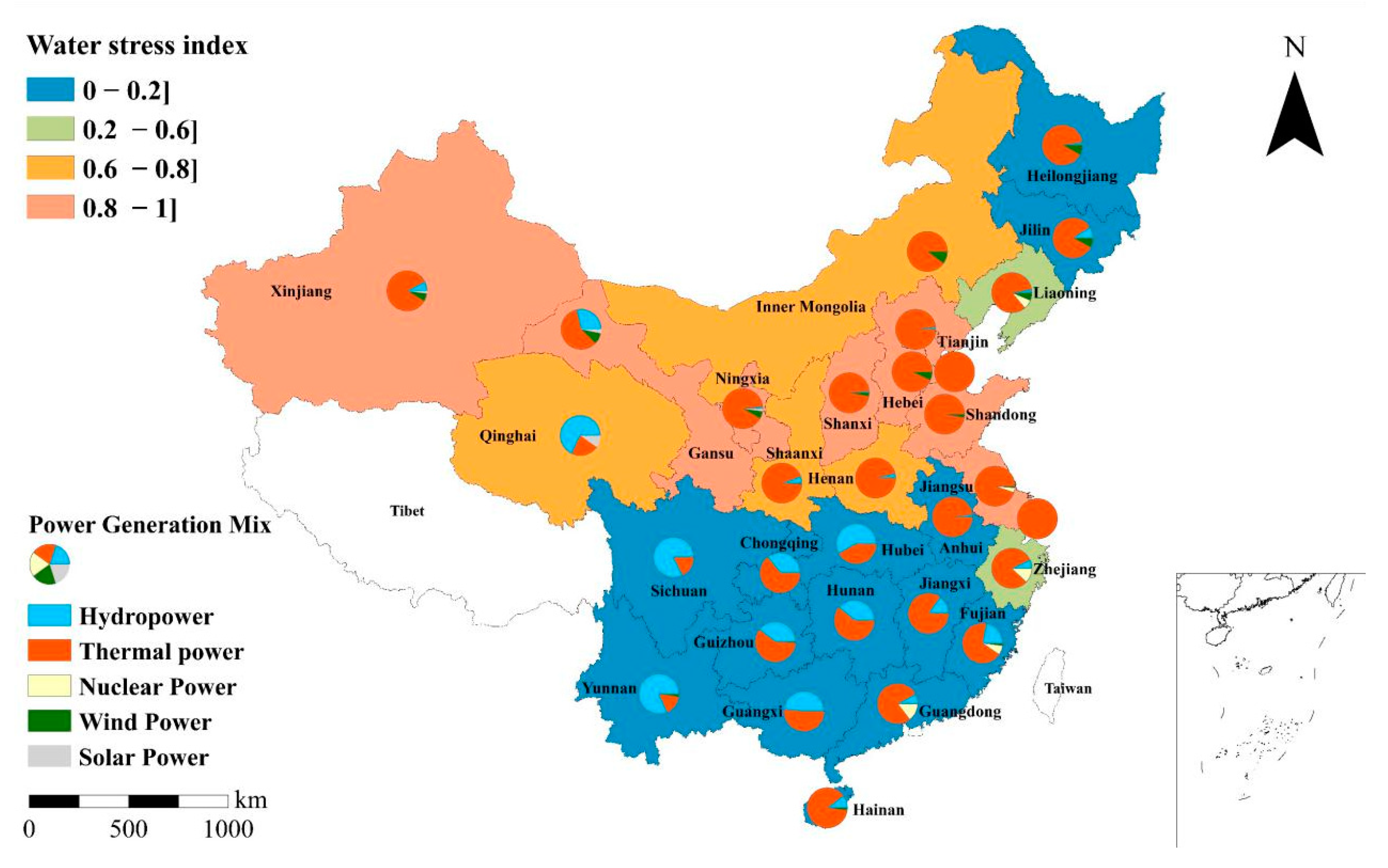
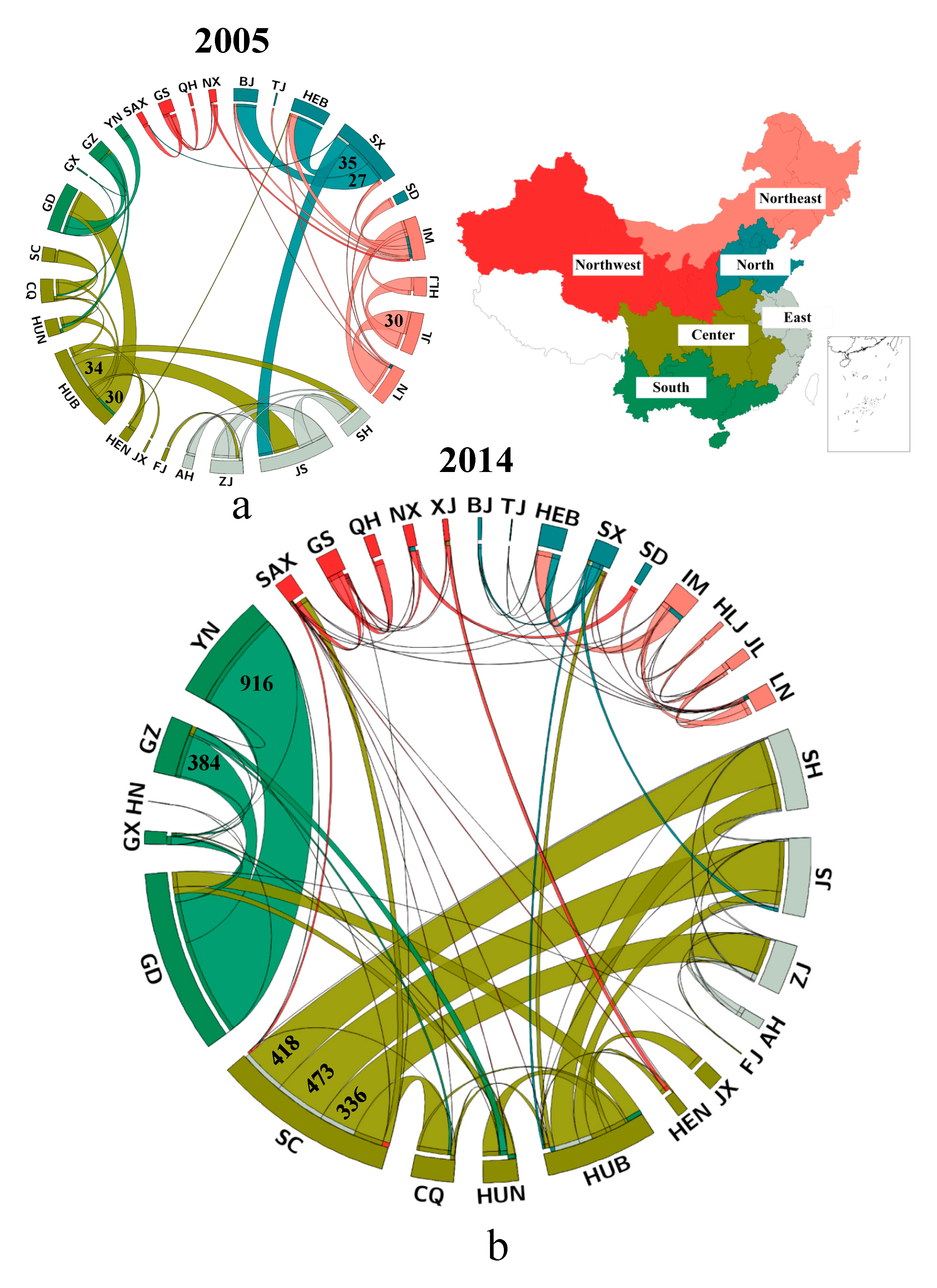
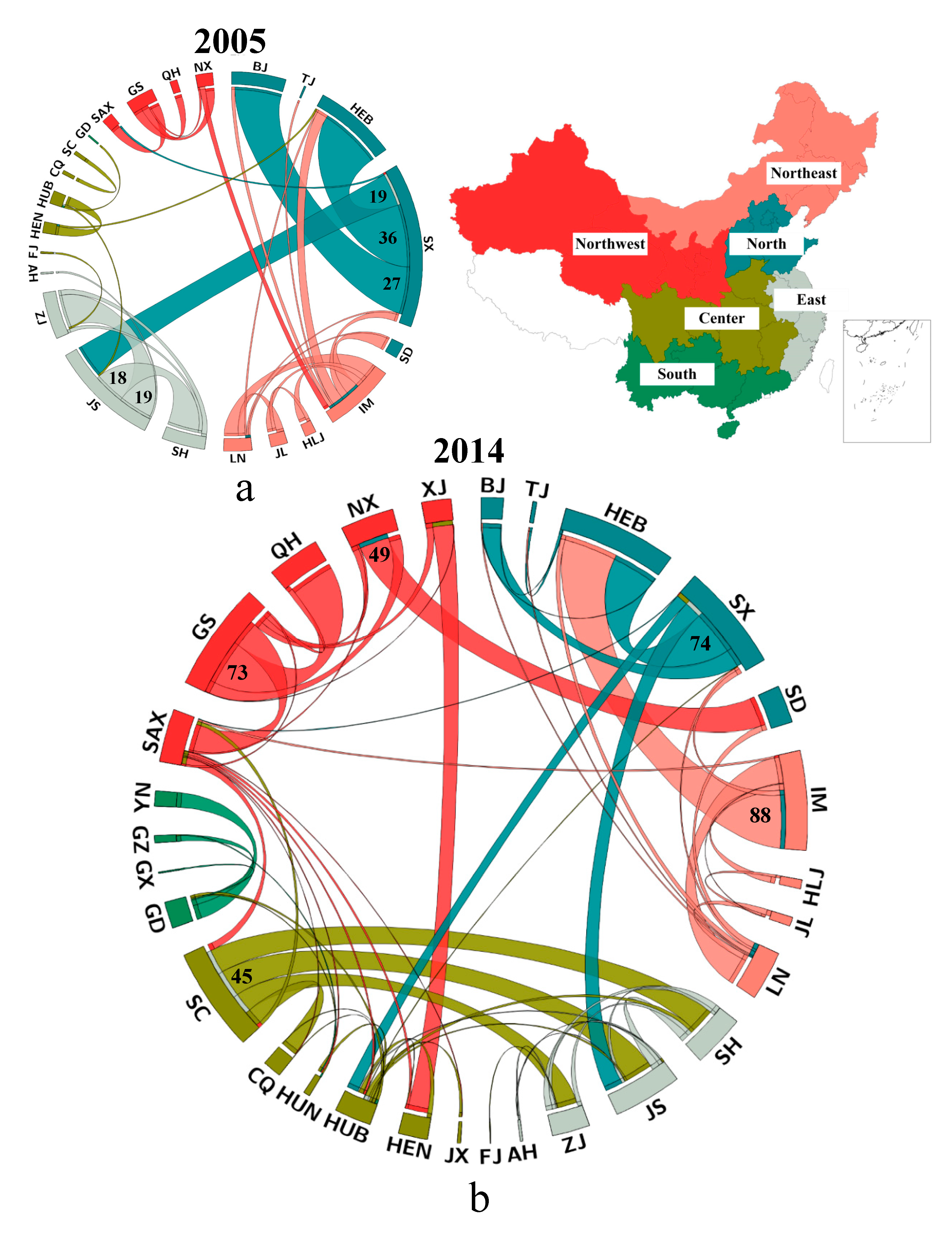
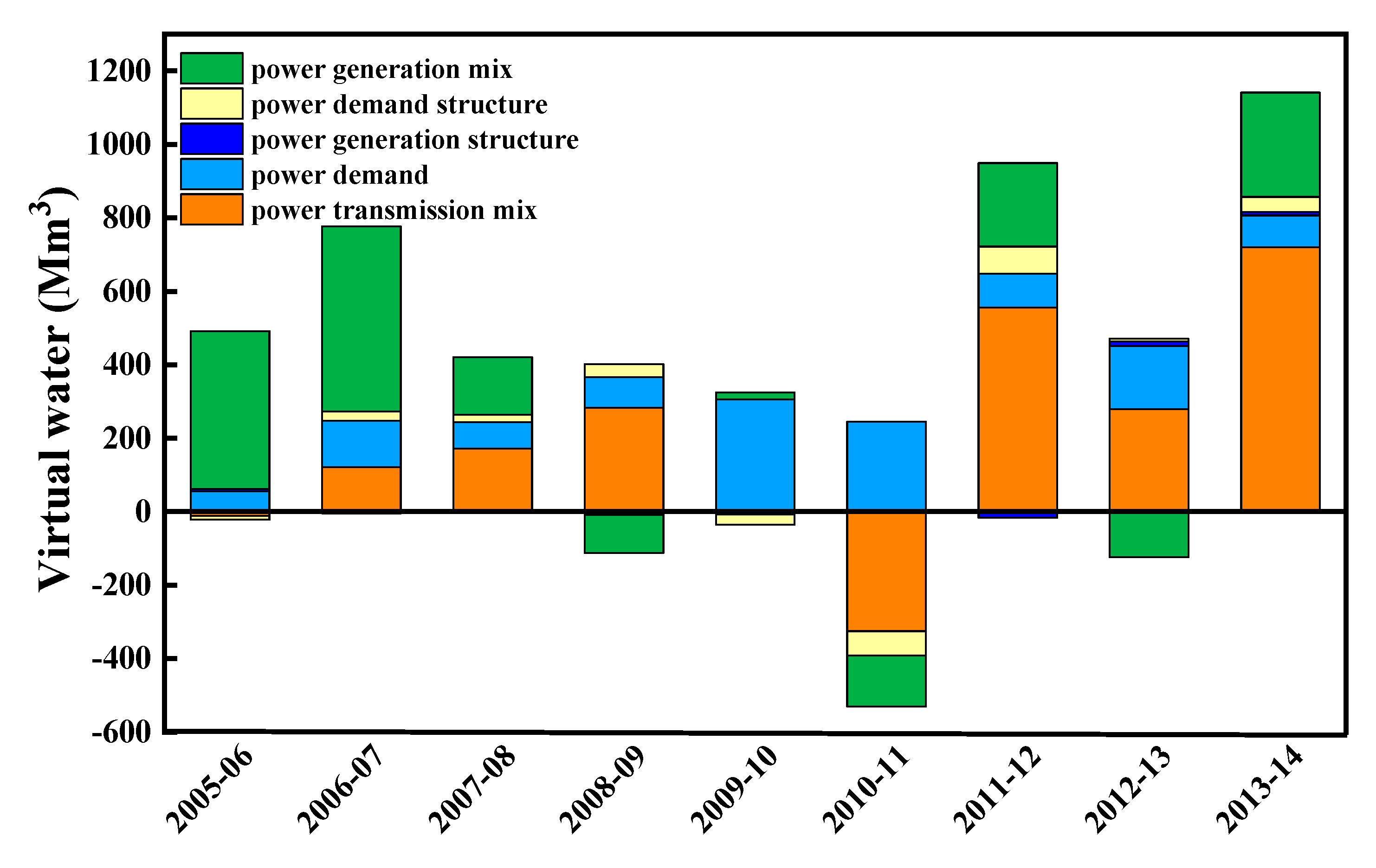
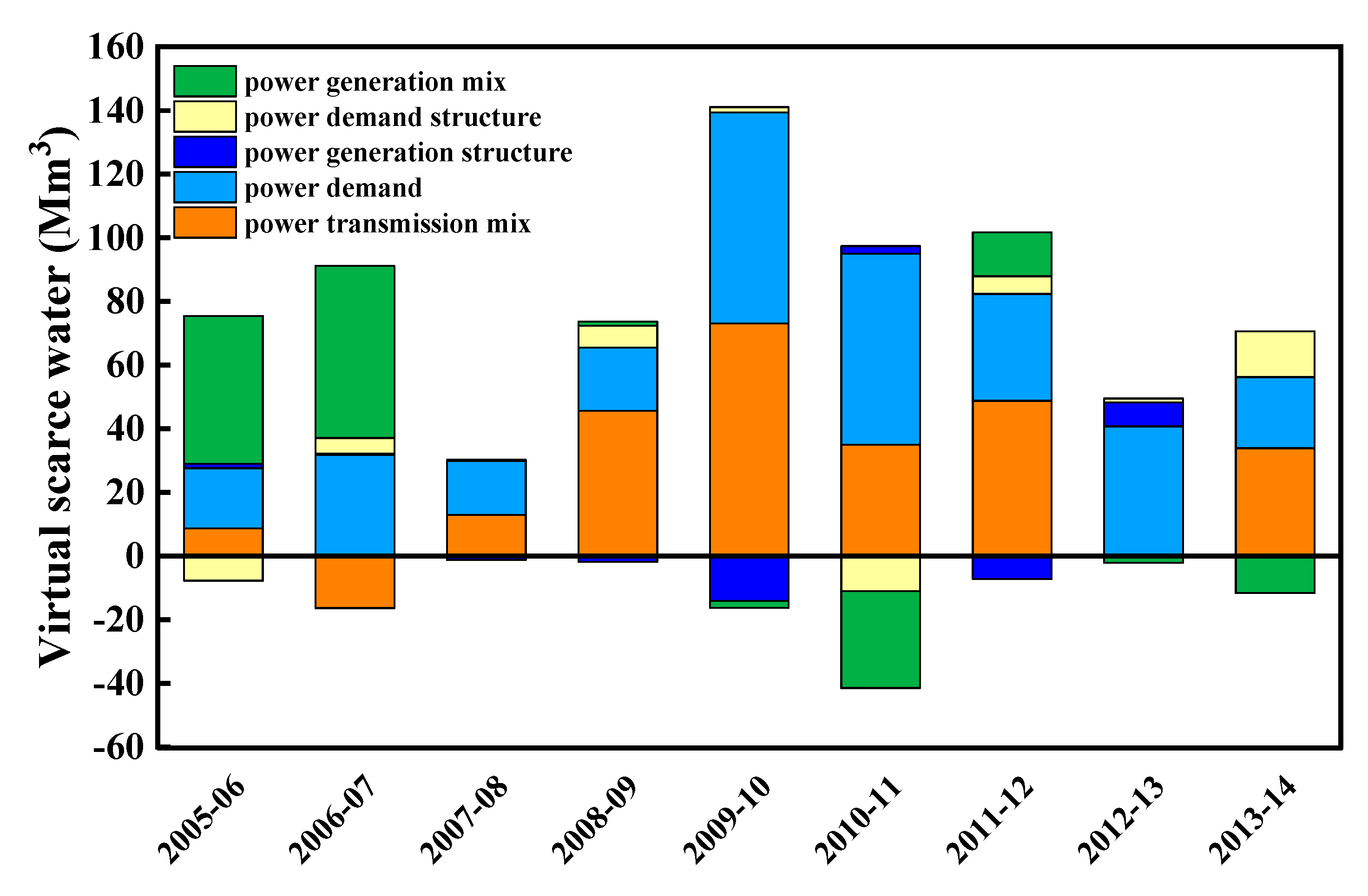
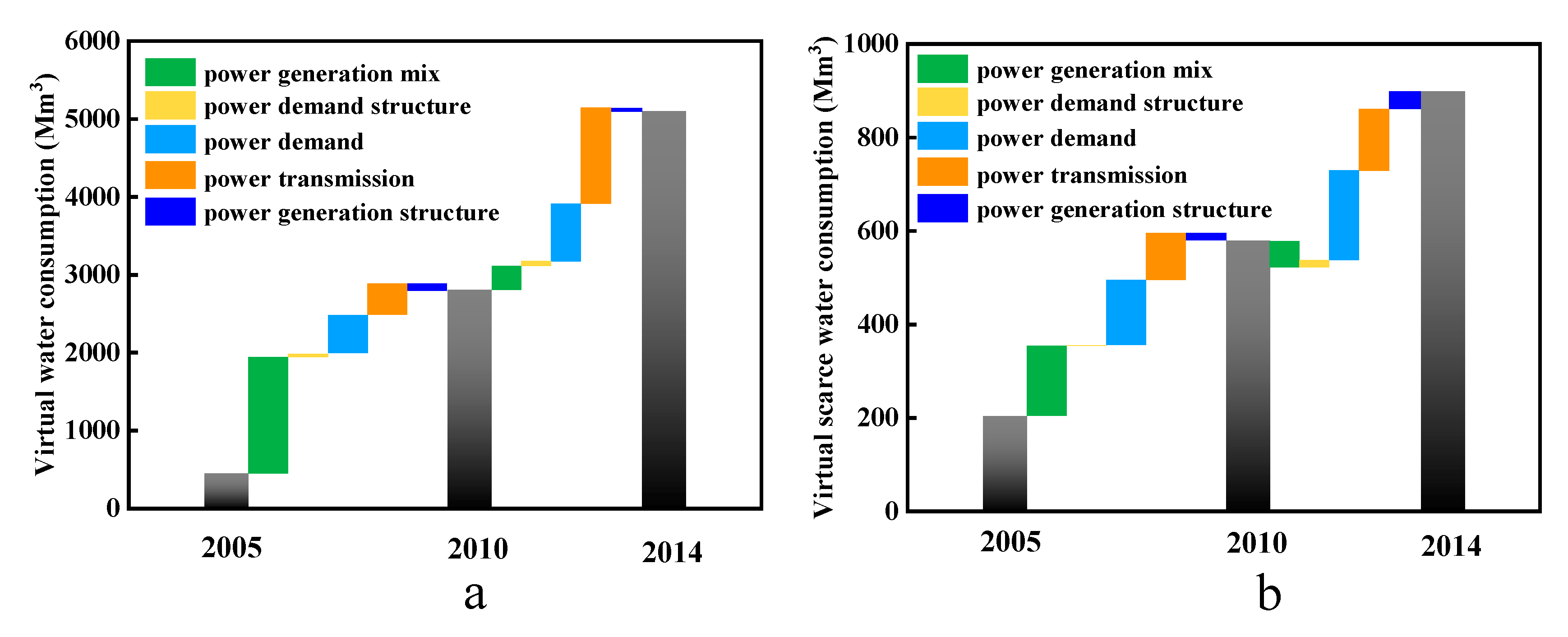
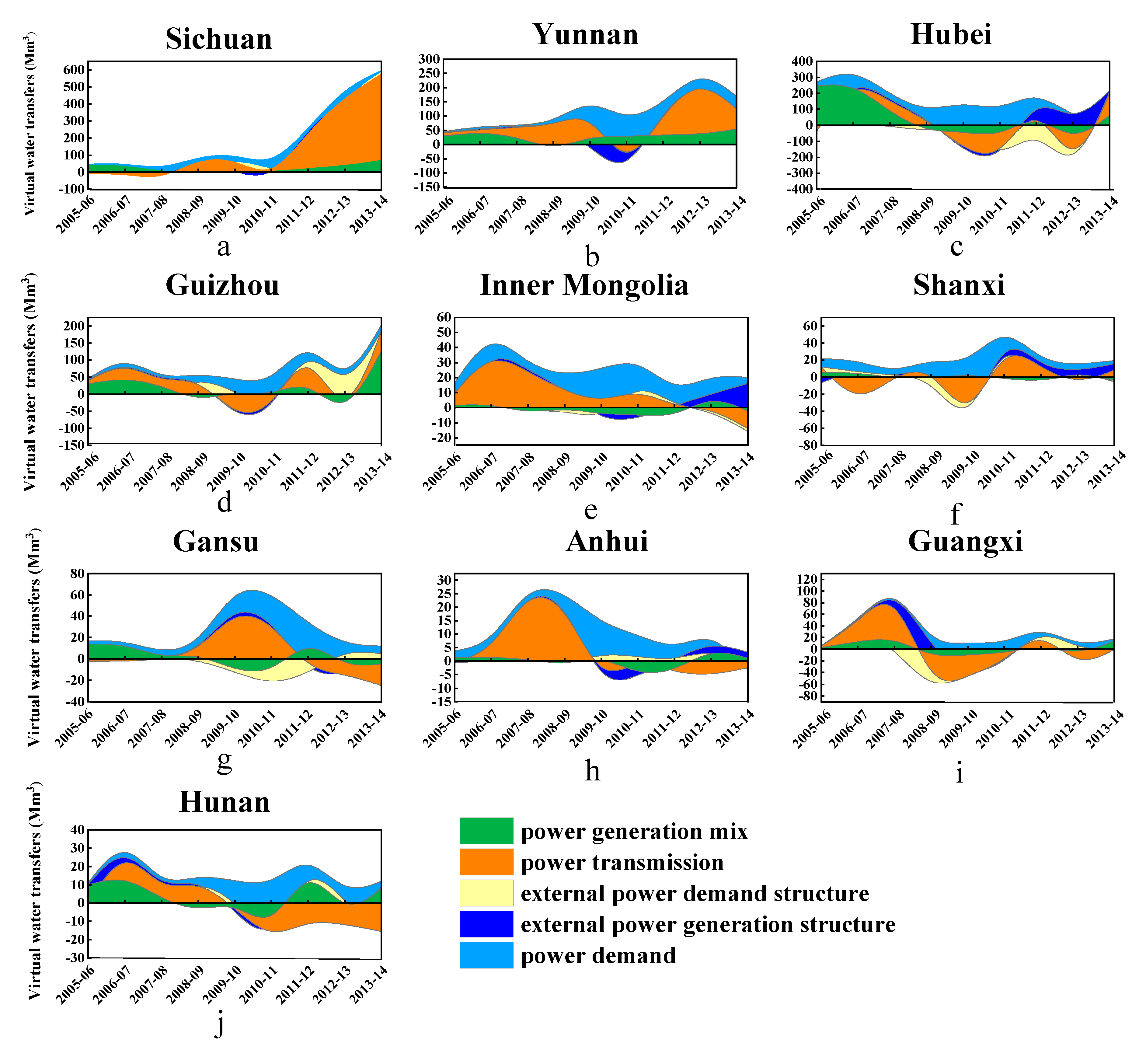
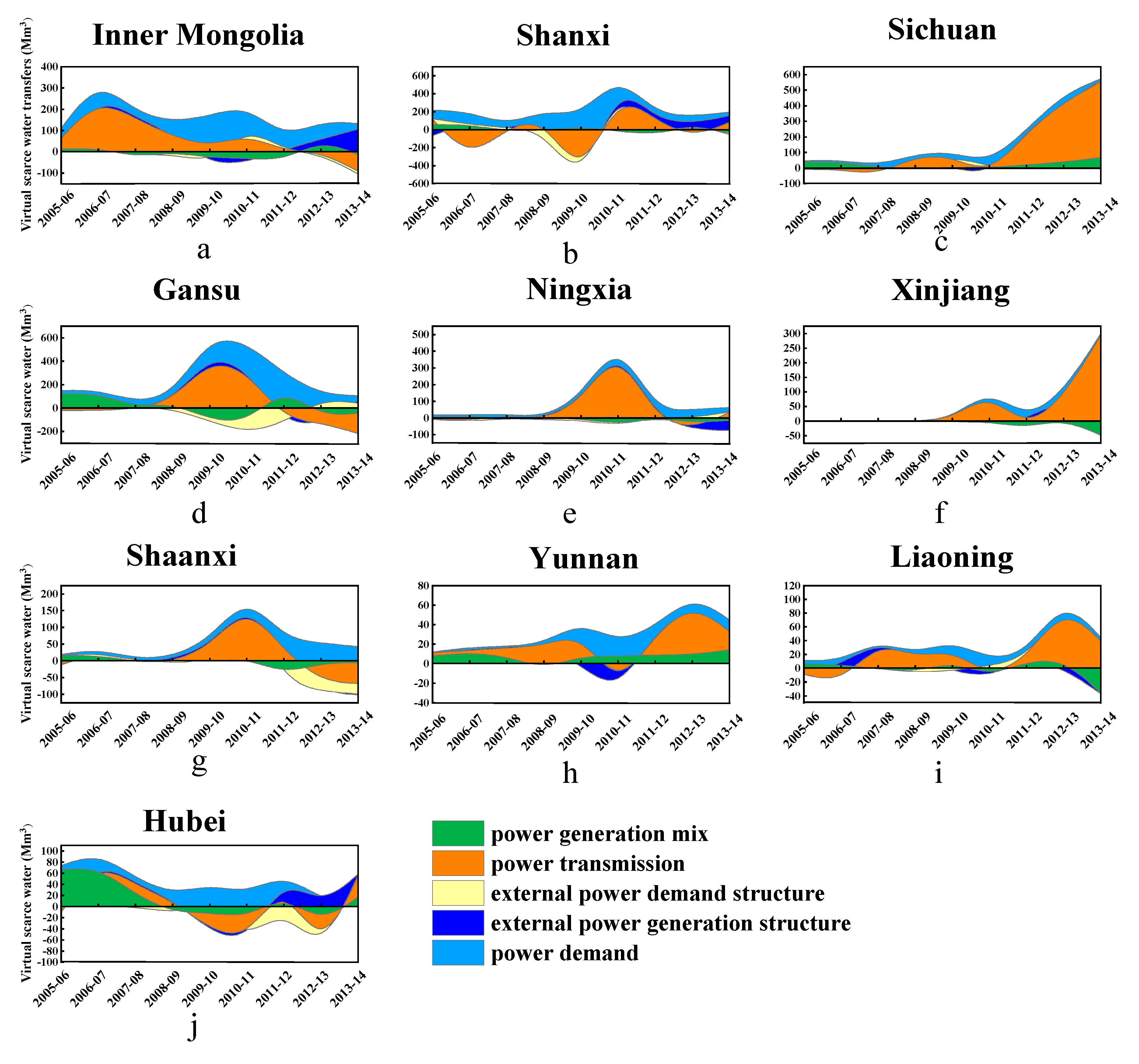
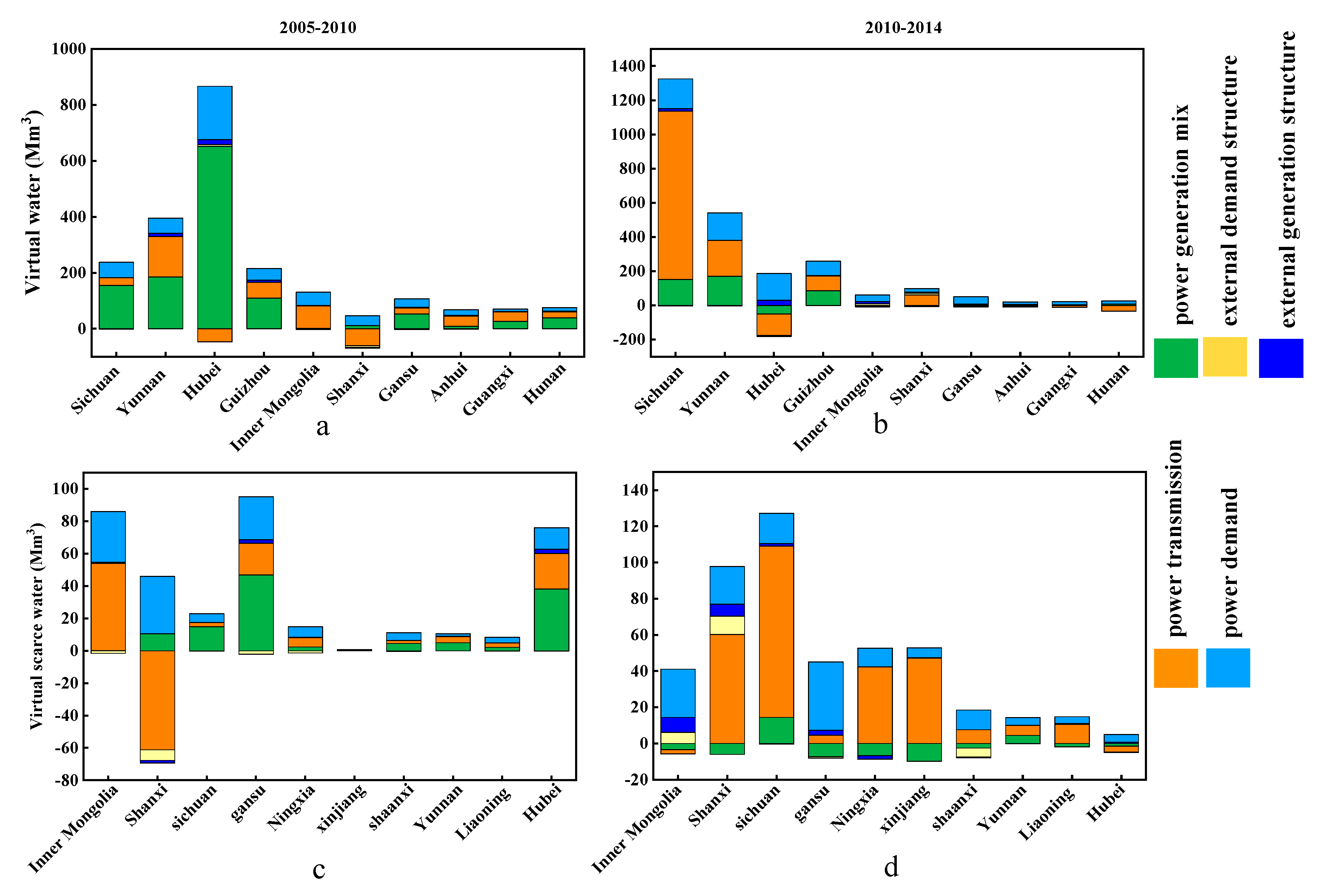
© 2020 by the authors. Licensee MDPI, Basel, Switzerland. This article is an open access article distributed under the terms and conditions of the Creative Commons Attribution (CC BY) license (http://creativecommons.org/licenses/by/4.0/).
Share and Cite
Zhang, Y.; Hou, S.; Liu, J.; Zheng, H.; Wang, J.; Zhang, C. Evolution of Virtual Water Transfers in China’s Provincial Grids and Its Driving Analysis. Energies 2020, 13, 328. https://doi.org/10.3390/en13020328
Zhang Y, Hou S, Liu J, Zheng H, Wang J, Zhang C. Evolution of Virtual Water Transfers in China’s Provincial Grids and Its Driving Analysis. Energies. 2020; 13(2):328. https://doi.org/10.3390/en13020328
Chicago/Turabian StyleZhang, Yiyi, Shengren Hou, Jiefeng Liu, Hanbo Zheng, Jiaqi Wang, and Chaohai Zhang. 2020. "Evolution of Virtual Water Transfers in China’s Provincial Grids and Its Driving Analysis" Energies 13, no. 2: 328. https://doi.org/10.3390/en13020328
APA StyleZhang, Y., Hou, S., Liu, J., Zheng, H., Wang, J., & Zhang, C. (2020). Evolution of Virtual Water Transfers in China’s Provincial Grids and Its Driving Analysis. Energies, 13(2), 328. https://doi.org/10.3390/en13020328






